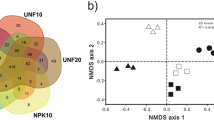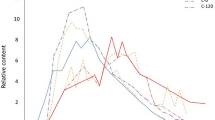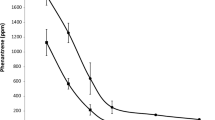Abstract
The response of soil microbiota to hydrocarbon contamination has been studied normally several months after the event. However, as those studies represent a “long-term” context for microbial processes, since protozoa succession can be achieved after 28 days, we wonder how fast does trophic structure of ciliates and flagellates recover from a strong pulse of petroleum contamination under the influence of Medicago sativa. We hypothesized that the root effect of M. sativa would promote faster recovery of the protozoan trophic structure, in comparison with the level reached in unplanted microcosms. The abundances of individuals, species, and trophic groups of ciliates and flagellates were determined at 1, 7, 14, and 30 days after a single pulse of 50,000 ppm of light petroleum on soil microcosms unplanted and planted with M. sativa, and their respective controls. Protozoan diversity and trophic groups were strongly reduced immediately after the pulse of contamination. Ciliates and flagellate trophic diversity increased steadily in all microcosms after 7 days. However, unplanted contaminated and planted contaminated microcosms remained the poorest communities and reached full recovery of trophic groups after 30 days. Also, the protozoan communities were segregated into 2 groups: the first from petroleum and the second formed by non-polluted microcosms. These results suggest that petroleum is a strong selection factor leading to an alternative protozoan community composition and the root effect of M. sativa promotes faster recovery of ciliate and flagellate communities after a devastation produced by a strong pulse of petroleum contamination.










Similar content being viewed by others
References
Agnello, A. C., Bagard, M., van Hullebusch, E. D., Esposito, G., & Huguenot, D. (2016). Comparative bioremediation of heavy metals and petroleum hydrocarbons co-contaminated soil by natural attenuation, phytoremediation, bioaugmentation and bioaugmentation-assisted phytoremediation. Science of the Total Environment, 563–564, 693–703. https://doi.org/10.1016/j.scitotenv.2015.10.061.
Aislabie, J. M., Balks, M. R., Foght, J. M. A., & Waterhouse, E. J. (2004). Hydrocarbon spills on Antarctic soils: effects and management. Environmental Science & Technology, 38(5), 1265–1274. https://doi.org/10.1021/ES0305149.
Alrumman, S. A., Standing, D. B., & Paton, G. I. (2015). Effects of hydrocarbon contamination on soil microbial community and enzyme activity. Journal of King Saud University - Science, 27, 31–41. https://doi.org/10.1016/j.jksus.2014.10.001.
Anderson, T. A., Guthrie, E. A., & Walton, B. T. (1993). Bioremediation in the rhizosphere. Environmental Science & Technology, 27(13), 2630–2636. https://doi.org/10.1021/es00049a001.
Bamforth, S. S. (1992). Sampling and enumerating soil protozoa. In A. T. Lee & J. J. Soldo (Eds.), Protocols in protozoology (p. B-5.1). Lawrence, Kansas: Allen Press.
Batani, G., Pérez, G., Martínez de la Escalera, G., Piccini, C., & Fazi, S. (2016). Competition and protist predation are important regulators of riverine bacterial community composition and size distribution. Journal of Freshwater Ecology, 31(4), 609–623. https://doi.org/10.1080/02705060.2016.1209443.
Bouwman, L. A., & Zwart, K. B. (1994). The ecology of bacterivorous protozoans and nematodes in arable soil. Agriculture, Ecosystems and Environment, 51, 145–160. https://doi.org/10.1016/0167-8809(94)90040-X.
Bray, R. H., & Kurtz, L. (1945). Determination of total, organic, and available forms of phosphorus is soils. Soil Science, 59(1), 39–46.
Brinch, U. C., Ekelund, F., & Jacobsen, C. S. (2002). Method for spiking soil samples with organic compounds. Applied and Environmental Microbiology, 68(4), 1808–1816. https://doi.org/10.1128/AEM.68.4.1808-1816.2002.
Cardinale, B. J., Srivastava, D. S., Duffy, J. E., Wright, J. P., Downing, A. L., Sankaran, M., & Jouseau, C. (2006). Effects of biodiversity on the functioning of trophic groups and ecosystems. Nature, 443, 989–992. https://doi.org/10.1038/nature05202.
Chen, X., Liu, M., Hu, F., Mao, X., & Li, H. (2007). Contributions of soil micro-fauna (protozoa and nematodes) to rhizosphere ecological functions. Acta Ecologica Sinica, 27(8), 3132–3143. https://doi.org/10.1016/S1872-2032(07)60068-7.
Clarholm, M. (1981). Protozoan grazing of bacteria in soil—impact and importance. Microbial Ecology, 7(4), 343–350. https://doi.org/10.1007/BF02341429.
Cortés-Pérez, S., Rodríguez-Zaragoza, S., & Mendoza-López, M. R. (2014). Trophic structure of amoeba communities near roots of Medicago sativa after contamination with fuel oil no. 6. Microbial Ecology, 67(2), 430–442. https://doi.org/10.1007/s00248-013-0305-1.
Cortés-Pérez, S., Rodríguez Zaragoza, S., Ferrera-Cerrato, R., & Luna-Pabello, V. M. (2018). Recovery of amoebae community in the root soil of M. sativa after a strong contamination pulse with n-hexane. Water, Air, & Soil Pollution, 229(9), 293. https://doi.org/10.1007/s11270-018-3944-5.
Coûteaux, M.-M., & Darbyshire, J. (1998). Functional diversity amongst soil protozoa. Applied Soil Ecology, 10(3), 229–237. https://doi.org/10.1016/S0929-1393(98)00122-X.
Das, N., & Chandran, P. (2011). Microbial degradation of petroleum hydrocarbon contaminants: an overview. Biotechnology Research International, 2011, 1–13. https://doi.org/10.4061/2011/941810.
Domonell, A., Brabender, M., Nitsche, F., Bonkowski, M., & Arndt, H. (2013). Community structure of cultivable protists in different grassland and forest soils of Thuringia. Pedobiologia, 56(1), 1–7. https://doi.org/10.1016/J.PEDOBI.2012.07.001.
Dotaniya, M. L., & Meena, V. D. (2015). Rhizosphere effect on nutrient availability in soil and its uptake by plants: a review. Proceedings of the National Academy of Sciences, India Section B: Biological Sciences, 85(1), 1–12. https://doi.org/10.1007/s40011-013-0297-0.
Dubinsky, E. A., Conrad, M. E., Chakraborty, R., Bill, M., Borglin, S. E., Hollibaugh, J. T., et al. (2013). Succession of hydrocarbon-degrading bacteria in the aftermath of the Deepwater Horizon oil spill in the Gulf of Mexico. Environmental Science & Technology, 47(19), 10860–10867. https://doi.org/10.1021/es401676y.
Ekelund, F., Olsson, S., & Johansen, A. (2003). Changes in the succession and diversity of protozoan and microbial populations in soil spiked with a range of copper concentrations. Soil Biology and Biochemistry, 35(11), 1507–1516. https://doi.org/10.1016/S0038-0717(03)00249-9.
Ekelund, F., & Rønn, R. (1994). Notes on protozoa in agricultural soil with emphasis on heterotrophic flagellates and naked amoebae and their ecology. FEMS Microbiology Reviews, 15(4), 321–353. https://doi.org/10.1016/0168-6445(94)90068-X.
Finlay, B. J., Black, H. I. J., Brown, S., Clarke, K. J., Esteban, G. F., Hindle, R. M., et al. (2000). Estimating the growth potential of the soil protozoan community. Protist, 151(1), 69–80. https://doi.org/10.1078/1434-4610-00008.
Foissner, W. (1991). Diversity and ecology of soil flagellates. In J. Patterson, David J, Larsen (Ed.), The biology of free-living heterotrophic flagellates (Systematic., p. pp.93–112). Clarendon Press Oxford.
Foissner, W. (1993). Colpodea (Ciliophora). Stuttgart: Gustav Fischer Verlag.
Foster, J. C. (1995). Soil nitrogen. In A. Kassem & N. Paolo (Eds.), Methods in applied soil microbiology and biochemistry (pp. 79–87). Academic Press London.
Gast, R. J., Sanders, R. W., & Caron, D. A. (2009). Ecological strategies of protists and their symbiotic relationships with prokaryotic microbes. Trends in Microbiology, 17(12), 563–569. https://doi.org/10.1016/J.TIM.2009.09.001.
Gennadiev, A. N., Pikovskii, Y. I., Tsibart, A. S., & Smirnova, M. A. (2015). Hydrocarbons in soils: origin, composition, and behavior (review). Eurasian Soil Science, 48(10), 1076–1089. https://doi.org/10.1134/S1064229315100026.
Girvan, M. S., Campbell, C. D., Killham, K., Prosser, J. I., & Glover, L. A. (2005). Bacterial diversity promotes community stability and functional resilience after perturbation. Environmental Microbiology, 7(3), 301–313. https://doi.org/10.1111/j.1462-2920.2005.00695.x.
Graj, W., Lisiecki, P., Szulc, A., Chrzanowski, Ł., & Wojtera-Kwiczor, J. (2013). Bioaugmentation with petroleum-degrading consortia has a selective growth-promoting impact on crop plants germinated in diesel oil-contaminated soil. Water, Air, and Soil Pollution, 224, 1676. https://doi.org/10.1007/s11270-013-1676-0.
Griffiths, B. S. (1990). A comparison of microbial-feeding nematodes and protozoa in the rhizosphere of different plants. Biology and Fertility of Soils, 9(1), 83–88. https://doi.org/10.1007/BF00335867.
Hamamura, N., Olson, S. H., Ward, D. M., & Inskeep, W. P. (2006). Microbial population dynamics associated with crude-oil biodegradation in diverse soils. Applied and Environmental Microbiology, 72(9), 6316–6324. https://doi.org/10.1128/AEM.01015-06.
Holtze, M. S., Ekelund, F., Rasmussen, L. D., Jacobsen, C. S., & Johnsen, K. (2003). Prey-predator dynamics in communities of culturable soil bacteria and protozoa: differential effects of mercury. Soil Biology and Biochemistry, 35(9), 1175–1181. https://doi.org/10.1016/S0038-0717(03)00178-0.
Holyoak, M., & Sachdev, S. (1998). Omnivory and the stability of simple food webs. Oecologia, 117(3), 413–419. https://doi.org/10.1007/s004420050675.
Jeuck, A., & Arndt, H. (2013). A short guide to common heterotrophic flagellates of freshwater habitats based on the morphology of living organisms. Annals of Anatomy, 164, 842–860. https://doi.org/10.1016/j.protis.2013.08.003.
Johnsen, A. R., de Lipthay, J. R., Sorensen, S. J., Ekelund, F., Christensen, P., Andersen, O., et al. (2006). Microbial degradation of street dust polycyclic aromatic hydrocarbons in microcosms simulating diffuse pollution of urban soil. Environmental Microbiology, 8(3), 535–545. https://doi.org/10.1111/j.1462-2920.2005.00935.x.
Kirk, J. L., Klironomos, J. N., Lee, H., & Trevors, J. T. (2005). The effects of perennial ryegrass and alfalfa on microbial abundance and diversity in petroleum contaminated soil. Environmental Pollution, 133(3), 455–465. https://doi.org/10.1016/j.envpol.2004.06.002.
Kuiper, I., Lagendijk, E. L., Bloemberg, G. V., & Lugtenberg, B. J. J. (2004). Rhizoremediation: a beneficial plant-microbe interaction. Molecular Plant-Microbe Interactions, 17(1), 6–15. https://doi.org/10.1094/MPMI.2004.17.1.6.
Lara, E., Berney, C., Ekelund, F., Harms, H., & Chatzinotas, A. (2007a). Molecular comparison of cultivable protozoa from a pristine and a polycyclic aromatic hydrocarbon polluted site. Soil Biology and Biochemistry, 39(1), 139–148. https://doi.org/10.1016/j.soilbio.2006.06.017.
Lara, E., Berney, C., Harms, H., & Chatzinotas, A. (2007b). Cultivation-independent analysis reveals a shift in ciliate 18S rRNA gene diversity in a polycyclic aromatic hydrocarbon-polluted soil. FEMS Microbiology Ecology, 62(3), 365–373. https://doi.org/10.1111/j.1574-6941.2007.00387.x.
Lee, J. J., Leedale, G. F., & Bradbury, P. C., Phyllis C. (2000). An illustrated guide to the protozoa: organisms traditionally referred to as protozoa, or newly discovered groups. Society of Protozoologists.
Lüftenegger, G., Foissner, W., & Adam, H. (1985). r-and K-selection in soil ciliates: a field and experimental approach. Oecologia, 66(4), 574–579. https://doi.org/10.1007/BF00379352.
Maliszewska-Kordybach, B. (2005). Dissipation of polycyclic aromatic hydrocarbons in freshly contaminated soils – the effect of soil physicochemical properties and aging. Water, Air, and Soil Pollution, 168(1–4), 113–128. https://doi.org/10.1007/s11270-005-0940-3.
Margesin, R., Labbé, D., Schinner, F., Greer, C. W., & Whyte, L. G. (2003). Characterization of hydrocarbon-degrading microbial populations in contaminated and pristine Alpine soils. Applied and Environmental Microbiology, 69(6), 3085–3092. https://doi.org/10.1128/aem.69.6.3085-3092.2003.
Muratova, A., Hübner, T., Narula, N., Wand, H., Turkovskaya, O., Kuschk, P., et al. (2003). Rhizosphere microflora of plants used for the phytoremediation of bitumen-contaminated soil. Microbiological Research, 158(2), 151–161. https://doi.org/10.1078/0944-5013-00187.
Naeem, S. (1998). Species redundancy and ecosystem reliability. Conservation Biology, 12(1), 39–45. https://doi.org/10.1111/j.1523-1739.1998.96379.x.
Nelson, D. H. W., & Sommers, L. E. (1982). Total carbon, organic carbon, and organic matter. In D. R. K. Page & R. H. Miller (Eds.), Methods of soil analysis. Part 2. Chemical and microbiological properties (pp. 539–580). Wisconsin: Madison.
Obire, O., & Anyanwu, E. (2009). Impact of various concentrations of crude oil on fungal populations of soil. Anyanwu Int. J. Environ. Sci. Tech, 6(2), 211–218. https://doi.org/10.1007/BF03327624.
Patterson, D. J. (1996). Free-living freshwater protozoa: a colour guide. Wiley.
Phillips, L. A., Greer, C. W., Farrell, R. E., & Germida, J. J. (2012). Plant root exudates impact the hydrocarbon degradation potential of a weathered-hydrocarbon contaminated soil. Applied Soil Ecology, 52, 56–64. https://doi.org/10.1016/j.apsoil.2011.10.009.
Pilon-Smits, E. (2005). Phytoremediation. Annual Review of Plant Biology, 56(1), 15–39. https://doi.org/10.1146/annurev.arplant.56.032604.144214.
Robertson, S. J., McGill, W. B., Massicotte, H. B., & Rutherford, P. M. (2007). Petroleum hydrocarbon contamination in boreal forest soils: a mycorrhizal ecosystems perspective. Biological Reviews, 82(2), 213–240. https://doi.org/10.1111/j.1469-185X.2007.00012.x.
Rykiel, E. J. (1985). Towards a definition of ecological disturbance. Austral Ecology, 10(3), 361–365. https://doi.org/10.1111/j.1442-9993.1985.tb00897.x.
Saleem, M., Fetzer, I., Harms, H., & Chatzinotas, A. (2013). Diversity of protists and bacteria determines predation performance and stability. The ISME Journal, 7(10), 1912–1921. https://doi.org/10.1038/ismej.2013.95.
Salehi-Lisar, S. Y., & Deljoo, S. (2015). The physiological effect of fluorene on Triticum aestivum, Medicago sativa, and Helianthus annus. Cogent Food & Agriculture, 1(1). https://doi.org/10.1080/23311932.2015.1020189.
Saul, D. J., Aislabie, J. M., Brown, C. E., Harris, L., & Foght, J. M. (2005). Hydrocarbon contamination changes the bacterial diversity of soil from around Scott Base, Antarctica. FEMS Microbiology Ecology, 53(1), 141–155. https://doi.org/10.1016/j.femsec.2004.11.007.
Trap, J., Bonkowski, M., Plassard, C., Villenave, C., & Blanchart, E. (2016). Ecological importance of soil bacterivores for ecosystem functions. Plant and Soil, 398(1–2), 1–24. https://doi.org/10.1007/s11104-015-2671-6.
Vaerewijck, M. J. M., Sabbe, K., Baré, J., & Houf, K. (2008). Microscopic and molecular studies of the diversity of free-living protozoa in meat-cutting plants. Applied and Environmental Microbiology, 74(18), 5741–5749. https://doi.org/10.1128/AEM.00980-08.
Van Hamme, J. D., Singh, A., & Ward, O. P. (2003). Recent advances in petroleum microbiology. Microbiology and Molecular Biology Reviews, 67(4), 503–549. https://doi.org/10.1128/MMBR.67.4.503-549.2003.
Wei, J., Liu, X., Zhang, X., Chen, X., Liu, S., & Chen, L. (2014). Rhizosphere effect of Scirpus triqueter on soil microbial structure during phytoremediation of diesel-contaminated wetland. Environmental Technology, 35(4), 514–520. https://doi.org/10.1080/09593330.2013.836549.
Xu, J. G., & Johnson, R. L. (1997). Nitrogen dynamics in soils with different hydrocarbon contents planted to barley and field pea. Canadian Journal of Soil Science, 77(3), 453–458 www.nrcresearchpress.com. Accessed 6 November 2018.
Zhang, M. M., Wang, N., Hu, Y. B., & Sun, G. Y. (2018). Changes in soil physicochemical properties and soil bacterial community in mulberry (Morus alba L.)/alfalfa (Medicago sativa L.) intercropping system. MicrobiologyOpen, 7(2). https://doi.org/10.1002/mbo3.555.
Acknowledgments
Laura Mondragón Camarillo acknowledges Posgrado en Ciencias Biológicas, UNAM, and CONACyT for their support in obtaining her doctoral degree.
Author information
Authors and Affiliations
Corresponding author
Additional information
Publisher’s Note
Springer Nature remains neutral with regard to jurisdictional claims in published maps and institutional affiliations.
Electronic Supplementary Material
ESM 1
(DOCX 44 kb)
Rights and permissions
About this article
Cite this article
Mondragón-Camarillo, L., Zaragoza, S.R., Mendoza-López, M.R. et al. Recovery of Soil Protozoan Community Structure Promoted by M. sativa After a Strong Pulse of Hydrocarbon Contamination. Water Air Soil Pollut 231, 283 (2020). https://doi.org/10.1007/s11270-020-04618-7
Received:
Accepted:
Published:
DOI: https://doi.org/10.1007/s11270-020-04618-7




